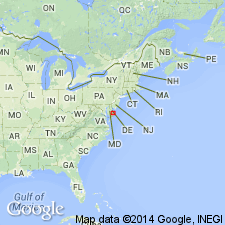
- Usage in publication:
-
- Beaverdam sand*
- Modifications:
-
- Original reference
- Dominant lithology:
-
- Sand
- Silt
- AAPG geologic province:
-
- Atlantic Coast basin
Summary:
Pg. 113, 115 (table 17), 116. Beaverdam sand. Composed of unconsolidated white to buff medium-grained quartz sand, with small quantities of coarse and fine sand, pebbles and granules, and a minor admixture of white silt. Thickness as much as 72 feet. In some places, underlies Walston silt (new); in others the Pamlico formation. Age is Pleistocene (Aftonian).
Reference locality (subsurface): test hole Wi-Cf 63, 2 mi east of Salisbury, [Salisbury 7.5-min quadrangle], Wicomico Co., southeastern MD. Crops out in banks and roadcuts surrounding Schumaker Pond, [Salisbury 7.5-min quadrangle, Wicomico Co., southeastern MD]. Named from Beaverdam Creek, east branch of Wicomico River, because of its prominent occurrence in and beneath drainage basin of that stream.
Source: US geologic names lexicon (USGS Bull. 1200, p. 259).

- Usage in publication:
-
- Beaverdam Formation
- Modifications:
-
- Biostratigraphic dating
- Age modified
- AAPG geologic province:
-
- Atlantic Coast basin
Summary:
Beaverdam Formation of Columbia Group in DE described as pale white to buff to greenish-gray medium sand with scattered beds of coarse sand, gravelly sand, and light gray to greenish-gray silty clay. Two facies recognized in fining-upward sequence: lower coarse sand with scattered gravel and upper silty, medium to coarse sand. Clay beds common in both facies. Base of Beaverdam is base of lowermost medium to coarse sand or gravel above the silts and clays or fine to medium sands of unconformably(?) underlying Bethany formation (informal) of Chesapeake Group. The Beaverdam unconformably underlies the Omar Formation of the Columbia Group. Unit is interpreted to have been deposited in a sand-dominated, fluvial to estuarine system. Lower part of the Beaverdam is of early Pliocene or late Miocene age and cannot be distinguished palynologically from the Bethany formation. Therefore, hiatus, if any, between the two was relatively short. Upper part of the Beaverdam contains fossil assemblage similar to Bacons Castle Formation of VA, which indicates a late Pliocene age.
Source: GNU records (USGS DDS-6; Reston GNULEX).
- Usage in publication:
-
- Beaverdam Formation
- AAPG geologic province:
-
- Atlantic Coast basin
Ramsey, K.W., 2010, Stratigraphy, correlation, and depositional environments of the middle to late Pleistocene interglacial deposits of southern Delaware: Delaware Geological Survey Report of Investigations, no. 76, 43 p.
Summary:
Pg. 3+. Beaverdam Formation. [Not synopsized to date. See also Ramsey, K.W., 2010, Geol. map Georgetown quadrangle, Delaware Geol. Survey, Geol. Map Ser., no. 15, scale 1:24,000, and references therein.]
Source: NA
For more information, please contact Nancy Stamm, Geologic Names Committee Secretary.
Asterisk (*) indicates published by U.S. Geological Survey authors.
"No current usage" (†) implies that a name has been abandoned or has fallen into disuse. Former usage and, if known, replacement name given in parentheses ( ).
Slash (/) indicates name conflicts with nomenclatural guidelines (CSN, 1933; ACSN, 1961, 1970; NACSN, 1983, 2005, 2021). May be explained within brackets ([ ]).

